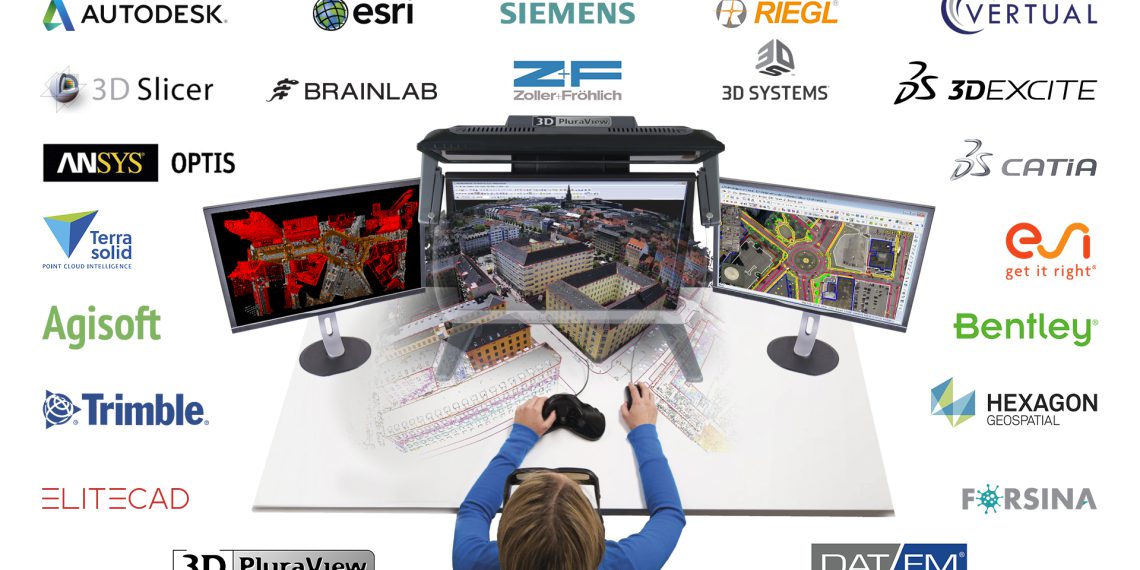Often, many users from the high-tech industries of biochemistry/molecule research, geoinformation (GIS, photogrammetry & LiDAR), medicine (CT, MRI & ultrasound) or construction (CAD, CAM & 3D printing) do not know which of the applications offered on the market are stereoscopy-capable and, in contrast to the monoscopic, perspective-flat display, thus enable true, spatial 3D visualization. After two years of intensive research, Schneider Digital, known for its professional 4K/8K and VR/AR hardware solutions, in collaboration with leading software manufacturers, has now published for the first time a global market overview of all relevant 3D stereo software solutions. In a monthly updated community-based database, more than 300 applications including manufacturers are currently listed and linked. Schneider Digital first checks the individual applications for their basic 3D stereo functionality before certifying them individually for plug-and-play operation with its 3D monitors or the smart VR wall.
With the continuous maintenance of this central database, in which all worldwide relevant 3D stereo software applications are summarized, Schneider Digital, as a specialist for 3D and VR/AR hardware solutions, provides users with a constantly updated orientation aid on how their work process and visualization quality can be improved through the use of 3D stereo technologies. One of the declared goals of the Miesbach-based company is to effectively help as many software manufacturers as possible to integrate the stereoscopic mouse pointer into their existing monoscopic applications in addition to the stereoscopic image output option, which enables users to reach every point, surface and edge in 3D space directly.
Schneider Digital has been providing not inconsiderable company resources for this pioneering work for two years now. The result is a manufacturer- and hardware-independent “Open Source Compendium” for all software manufacturers and users. The global market overview shows at a glance which of the software applications offered are really natively 3D-stereo capable. In other words — “which software is able to display models in detail, holographically as real 3D objects in space and which software already has a 3D stereo cursor”?
Cross-industry compendium of 3D stereo applications
To achieve its vision of creating a fully comprehensive market overview of all relevant 3D stereo applications, Schneider Digital reviewed more than 300 software applications for their 3D stereo functionality. Most of them have already been certified by the company for operation with its own passive 3D monitor systems, the 3D PluraView models.
The applications are sorted according to software and application areas and are listed and linked in alphabetical order, together with details of the respective manufacturers. With the help of this overview, software manufacturers and users can quickly and conveniently filter out a solution tailored to their requirements. There are also plans to further expand the compendium with video tutorials for 3D stereo configuration settings as well as a graphics card database with all suitable stereo-capable, professional graphics card solutions.
“Our vision is to continuously expand this market overview into a complete, community-based database of all relevant 3D stereo applications worldwide. In addition to listing all manufacturers and applications, we also want to integrate the corresponding documentation, how-to’s and video tutorials for software configuration there.”
- Josef Schneider, project initiator
Complete 3D stereo workstation solutions — a combination of powerful software and hardware
Working with holographically displayed 3D models is becoming increasingly established in applications such as research, analytics, development, construction, design or diagnostics. A 3D monitor has become the industry standard for all stereoscopic software applications because it guarantees precise 3D stereo visualization in the highest resolution up to 4K per eye. It is used in a wide range of industries, such as photogrammetry, GIS/mapping, LiDAR point clouds, laser scanning, oil and gas prospecting, archaeology, AEC/BIM, visualization of 3D city models, CAx, medical or biotechnology and molecular chemistry.
3D visualization technology is a complex subject area that only the perfect interaction of software and hardware components leads to one hundred percent industry-standard visualization results. Schneider Digital has over 25 years of industry and product experience with sophisticated professional hardware and has detailed market knowledge and application expertise. Schneider’s experience has shown: The combination of computational performance and visualization technology is critical! If you use a 3D stereo software solution and want to work stereoscopically or with VR/AR, you need a powerful CPU/GPU hardware solution.
Only in perfect interaction with powerful professional hardware can landscapes, buildings, entire cities, complex CAD models, GIS infrastructure, industrial processes or human anatomy be processed and visualized in a three-dimensional, detailed and fluid way. The larger the data sets to be processed, the higher the demands on the performance of the workstations and the image quality of the 3D monitors. Professional users with demanding 3D work tasks benefit from Schneider Digital visualization technology in combination with powerful workstations and 3D/VR/AR input devices as a complete workstation solution.

















